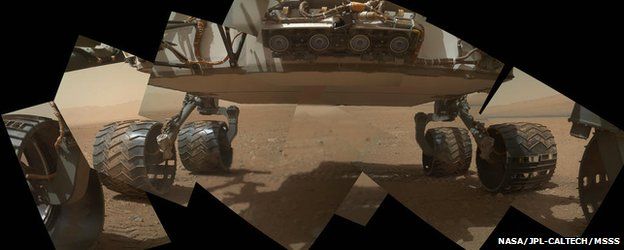Curiosity Mars rover to 'drive, drive, drive'
- Published

The Mars Curiosity rover has all but completed its commissioning phase and is ready to begin its detailed investigation of the Red Planet.
The six-wheeled vehicle touched down in Gale Crater on 6 August (GMT).
Since then, daily activities have been dominated by system checkouts and instrument calibration work.
US space agency engineers say they have one final day of testing on Curiosity's robotic arm to complete before handing the rover over to the scientists.
"After that, starting on Friday evening, the plan is to drive, drive, drive!" said Jennifer Trosper, a mission manager from Nasa's Jet Propulsion Laboratory.
Curiosity is heading towards a place on the crater floor dubbed Glenelg - a location some 400m from the rover's August landing site and where satellite images have identified a junction between three types of geological terrain.
On the way, the rover will stop at a rock where it can fully use some of the tools on the end of the robotic arm. These will include the "hand lens" known as Mahli and the X-ray spectrometer known as APXS, which is able to determine the chemical elements that are present in a rock.
Even in the next few days, the science will ramp up as Curiosity uses its mast camera system to image the passage of Mars' two moons, Phobos and Deimos, across the face of Sun.
"This occurrence of transits happens twice per Martian year which is once every Earth year," said Joy Crisp, the deputy project scientist. "What we're planning on doing is taking video with the Mastcam." However, she cautioned it might take some time to download all the frames.
At some point in the next few weeks, the science team plans to command the rover to take a soil sample into its two big onboard laboratories.
All these tasks mean the arrival at Glenelg is likely to be at least a month away.
Curiosity's long-term target within Gale Crater is its central 5km-tall mountain known as Mount Sharp.
Scientists expect Curiosity to find layered rock deposits at the base of this peak that should provide new insights on past environmental conditions on the Red Planet - conditions that may have supported microbial life many billions of years ago.
The vehicle - also known as the Mars Science Laboratory - is funded for two Earth years of operations. But many expect the mission to roll and roll for perhaps a decade or more.
- (A) Curiosity will trundle around its landing site looking for interesting rock features to study. Its top speed is about 4cm/s
- (B) This mission has 17 cameras. They will identify particular targets, and a laser will zap those rocks to probe their chemistry
- (C) If the signal is significant, Curiosity will swing over instruments on its arm for close-up investigation. These include a microscope
- (D) Samples drilled from rock, or scooped from the soil, can be delivered to two hi-tech analysis labs inside the rover body
- (E) The results are sent to Earth through antennas on the rover deck. Return commands tell the rover where it should drive next
Jonathan.Amos-INTERNET@bbc.co.uk and follow me on Twitter: @BBCAmos
- Published10 September 2012
- Published10 September 2012
- Published6 September 2012
- Published30 August 2012
- Published28 August 2012
- Published22 August 2012
- Published23 August 2012
- Published21 August 2012
- Published20 August 2012
- Published20 August 2012
- Published17 August 2012
- Published14 August 2012
- Published13 August 2012
- Published11 August 2012
- Published9 August 2012
- Published9 August 2012
- Published8 August 2012
- Published7 August 2012
- Published7 August 2012
- Published6 August 2012
- Published4 August 2012